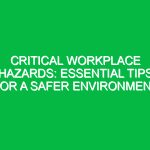Introduction
Hello team! Thank you for gathering today for this important Toolbox Talk. Our focus is on a critical aspect of our daily operations: Radio Communication on the Job. Effective communication is vital in our Health, Safety, and Environment (HSE) efforts, ensuring that everyone is informed and safe while performing their duties. Today, we will explore the significance of radio communication, share Best Practices, and discuss how we can enhance our Safety culture through effective communication.
Why Radio Communication Matters
In our work environment, radio communication serves as a lifeline. It allows instant communication between team members, facilitating quick decision-making, alerting others to Hazards, and coordinating activities. Whether you’re in the field, on a construction site, or in a manufacturing facility, clear and effective radio communication can prevent accidents and save lives.
The Role of Radio Communication in HSE
In the HSE context, radio communication enhances Safety by:
- Immediate Alerts: Radios can be used to quickly inform team members of potential Hazards or emergencies.
- Coordination: Effective communication helps coordinate tasks, ensuring that everyone knows their responsibilities and the status of operations.
- Feedback Loop: Radios provide a means for workers to report issues or suggest improvements, fostering a culture of safety.
- Documentation: Communication over radios can serve as a record of Safety Measures taken and incidents reported.
Real-Life Scenarios
Let’s consider a hypothetical scenario: Imagine a construction site where a worker notices a potential hazard, such as a loose scaffold. Without effective radio communication, this information might not reach the team promptly, increasing the risk of an accident. However, if the worker uses their radio to report the hazard immediately, the team can take swift action to rectify the situation, ensuring everyone’s safety.
Best Practices for Radio Communication on the Job
To maximize the effectiveness of radio communication, we need to follow some Best Practices:
- Use Clear Language: Avoid jargon and be as clear as possible. Use standard phrases to minimize confusion.
- Check Your Equipment: Ensure that your radio is functioning correctly before starting work. Test the battery and the clarity of sound.
- Be Concise: Keep your messages short and to the point. Long-winded messages can lead to miscommunication.
- Listen Actively: Pay attention when others are speaking. This is crucial to ensure you receive all necessary information.
- Confirm Receipt: Always acknowledge messages to confirm that you’ve understood the communication. A simple “copy” or “received” can suffice.
Potential Hazards and Risks
While radio communication is essential, it is important to recognize that improper use can also pose risks. For example:
- Distraction: Using radios while performing tasks that require full attention can lead to accidents.
- Interference: Background noise can disrupt communication, making it hard to hear important messages.
- Miscommunication: If messages are not clear or confirmed, it can lead to misunderstandings and safety breaches.
Regulations and Standards
It’s crucial to be aware of any Regulations and standards regarding radio communication in our industry. Compliance with these standards not only ensures safety but also meets legal obligations. Familiarize yourself with:
- OSHA Regulations: The Occupational Safety and Health Administration provides guidelines on communication in the workplace.
- Company Policies: Review our internal policies on radio usage and communication protocols.
Actionable Advice for Effective Communication
To further enhance our radio communication practices, consider these actionable tips:
- Participate in Training: Attend any training sessions offered on effective radio use and communication skills.
- Practice Regularly: Use radios in practice drills to become familiar with the equipment and protocols.
- Engage in Role-Playing: Simulate scenarios where radio communication is critical to reinforce learning.
- Provide Feedback: Encourage team members to share their experiences and suggestions for improving communication.
Discussion and Engagement
Now, let’s open the floor for discussion. What challenges have you faced regarding radio communication on the job? How can we work together to improve our practices? Feel free to share your thoughts or experiences.
Conclusion
In conclusion, effective Radio Communication on the Job is a cornerstone of our Health, Safety, and Environment initiatives. By following best practices, understanding the importance of clear communication, and being aware of potential hazards, we can foster a safer and more efficient workplace. Thank you for your attention and commitment to improving our communication practices. Together, let’s ensure that we maintain a safe working environment for everyone.


